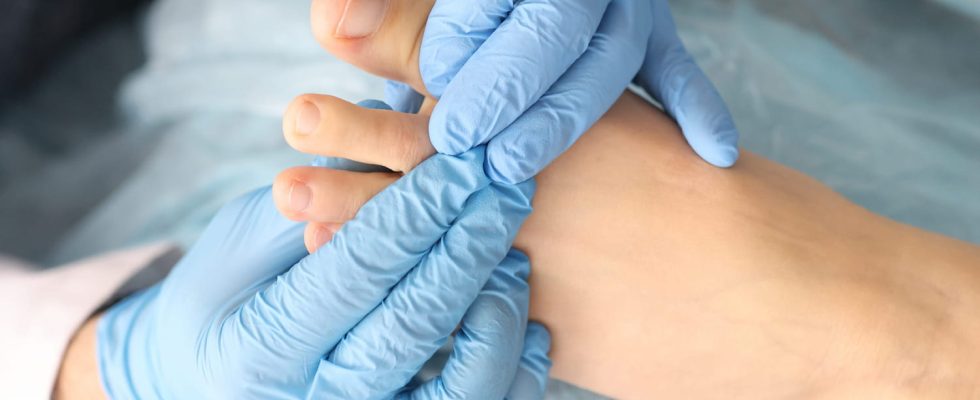Mycosis of the foot or toe (“athlete’s foot”) is very contagious. It usually occurs between the toes, on the nails or under the soles of the feet. The right treatments with our expert.
Mycosis of the feet or “athlete’s foot” is a superficial skin infection located between the toes. If left untreated, foot mycosis, very contagiouscan spread up to the nail. The dermatologist may prescribe a cream adapted. Some essential oils and the baking soda are part of natural treatments to cure foot fungus. What is foot fungus? What are the causes ? What are the symptoms foot fungus? What treatments for the cure ? What to do ?
What is foot fungus?
“Athlete’s foot” is a particular form of localized mycosis of the feet between the toes. This superficial skin infection caused by a fungus can affect the solesTHE nails, and other localizations on the skin apart from the feet. It can be the gateway to other infections, particularly bacterial ones (erysipelas). Heat and humidity are favorable factors for the development of the fungus.
Foot fungus is caused by a fungus called dermatophyte. The latter contaminates the skin and develops in particular between the toes. “Contamination most often occurs indirectly, when walking barefoot in hot and humid environments such as swimming pools, locker rooms, saunas, gyms. The fungus remains there between the toes then multiplies and spreads to skin and nails”explains Doctor Clélia Vanhaecke, hospital practitioner in the Dermatology-Venereology department at the Reims University Hospital.
Is foot fungus contagious?
Athlete’s foot mycosis is not serious, but is very unpleasant and contagious. “An untreated infected person can self-contaminate on other parts of the body. It can also infect other people, mainly by indirect contact (loss of small dead skin containing fungi, especially in places conducive to the development of the fungus, hot and humid)”, says the doctor.
What are the symptoms of foot fungus?
The first signs usually begin between the 3rd and 4th toe or between the 4th and 5th. It appears a rednessoften with itching important or even burns. Evolution can take place towards the appearance of a crackwhich can be painful, small blisters (vesicles) may be visible.
“We must avoid wearing closed shoes all the time.”
Medications for yeast infection can be taken in the form of gels, creams, spray or tablets. “Hygiene measures are essential in the treatment of foot fungus: wash the feet well with soap and water, dry well, especially the areas between the toes, with a cold hair dryer if passing the towel is painful, then apply the prescribed treatment and respect the prescribed duration, which varies according to the molecule used”recalls Dr. Clélia Vanhaecke. Ventilation of lesions as much as possible is recommended (limit the wearing of closed shoes).
► The baking soda is excellent for treating foot fungus. Just dilute 4 tablespoons of bicarbonate in powder form in 1L of lukewarm water and bathe your feet in it for 15 minutes. Then, it is important to dry them well in order to eliminate moisture.
► Several essential oils also provide considerable help in the fight against mycosis of the feet thanks to their antifungal properties. For example, those oftea tree (or “tea tree”), lavender and Atlas cedar have these properties. Each of these oils can be mixed with sweet almond oil and applied directly to the affected area with a few drops.
If, in general, fungal infections of the feet are not dangerous, they are on the other hand annoying and stubborn. And since there is no hope of spontaneous healing, it is better to regularly monitor your feet, especially the spaces between your toes. “It’s necessary avoid wearing closed shoes all the time, insists the specialist. This monitoring must be even more rigorous in people suffering from diabetes, a mycosis of the feet can progress, in this case, to serious chronic wounds and lead to amputation.
What are the predisposing factors of mycosis of the feet?
- Athlete’s foot is very common in sporty. Wearing sports shoes contributes to the increase in the frequency of this mycosis.
- The wearing of closed shoes causes a warm and humid environment, favorable to the development of fungi.
- A decrease in immune defenses can promote the development of this fungus (for example: taking corticosteroids.).
- THE diabetes is also a risk factor for mycosis of the feet, by the reduction of defenses and other factors which favor microtraumas which facilitate the penetration of the fungus into the skin (neurological and/or arterial damage linked to diabetes). Foot wounds in people with diabetes should be taken very seriously because they can, in certain situations, lead to amputation.
- THE circulatory disorders such as venous insufficiency (history of varicose veins), lymphatic insufficiency (frequent in cases of overweight or obesity) and arterial insufficiency (arteritis) also promote fungal infections by weakening the skin.
It is possible to prevent this type of yeast infection by taking the right steps: dry your feet wellespecially between the toes, limit the wearing of closed shoes, avoid walking barefoot in locker rooms sports halls, swimming pools… It is also advisable to wash your shoes/slippers, to treat all the other areas affected by mycosis and to pay attention to foot injuries.
If left untreated, foot fungus can win all toes. The infection can also reach the top or bottom of the foot at the level of the soles which becomes thick, scaly (so-called mealy appearance). THE nails feet can be affected, thicken, whiten initially then turn yellow or even blacken and become crumbly. The damage may extend to other locations on the skin (palm of the hands if manipulation, other folds..) This cutaneous mycosis can be the gateway for bacterial infection more severe (erysipelas, affecting the leg, with fever, pain),
Thanks to Doctor Clélia Vanhaecke, Hospital Practitioner, Dermatology-Venereology Department CHU Reims, Member of the GrIDIST (Dermatological Infectiology Group Sexually Transmitted Infections) of the French Society of Dermatology (SFD).
